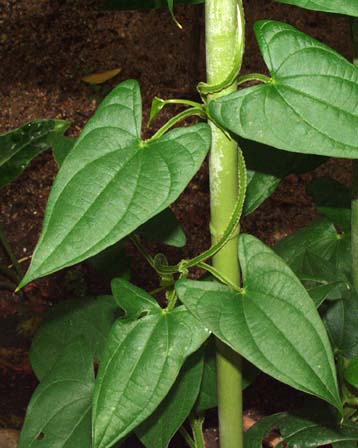|
Greater yam (Dioscorea alata) is predominantly a tropical plant. The crop
cannot withstand frost and excessively high temperatures. Temperature around 30ºC
and rainfall of 120-200 cm distributed throughout the growth period are ideal. Day
length greater than 12 hours during initial stages and shorter day length during
the later part of the growing season favour satisfactory tuber formation. Yam requires
loose, deep, well-drained, fertile soil. The crop does not come up well in waterlogged
conditions.

Season
Seed tubers are normally planted during the later part of the dry season (March-April)
and start sprouting with the onset of pre-monsoon showers. If the planting is delayed,
yams start sprouting in storage, which is not desirable for planting.
Varieties
Sree Keerthi: Suitable for
intercropping in mature coconut garden and with banana.
Sree Roopa: Possesses excellent
cooking quality.
Indu: This is recommended as
a pure crop and also as an intercrop of coconut in the reclaimed alluvial soils
of Kuttanad.
Sree Shilpa: This is the first
hybrid having good culinary quality. The crop matures early, within 8 months. The
tubers have 33-35% dry matter, 17-19% starch, 1.4-2% protein and 0.8-1.2% sugar.
Sree Karthika: High yield,
excellent cooking quality. The crop matures within 9 months. The tubers have 21.42%
starch, 1.14% sugar and 2.47% crude protein.
Seeds and sowing
Greater yam produces mostly a single big tuber in which only one head end of the
tuber is available as good seed material. For getting the head end in each propagation
unit, the whole tuber is divided longitudinally. Each piece of cut tuber should
weigh at least 250-300 g. Dip the pieces in cowdung slurry and allow to dry under
the shade before planting. About 2500-3000 kg of seed material is required to cover
one hectare of land.
Preparation of land
Plough or dig the land up to a depth of 15-20 cm. Dig pits of size 45 x 45 x 45
cm at a distance of 1 x 1m. Fill up three fourth of the pits with 1-1.25 kg cattle
manure or compost and mix with topsoil. Plant the cut tuber pieces and completely
cover the pit with leafy materials to conserve soil moisture and maintain optimum
temperature.
Manuring
Apply cattle manure or compost at 10-15 t/ha as basal dressing. A fertilizer dose
of 80:60:80 kg of N:P2O5:K2O per ha has to be applied
in two splits; half dose of N, full P2O5 and half of K2O
within a week after sprouting; remaining half N and half K2O one month
after the first application along with weeding and earthing up.
Plant protection
Yam scale is found to infest the corms both under field and storage situations.
Trailing
Trailing is essential to expose the leaves to sunlight. Trailing has to be done
within 15 days after sprouting by coir rope attached to artificial supports in the
open areas or to trees where they are raised as an intercrop. When grown in open
areas, trail to a height of 3-4 m. Trail the vines properly as and when side shoots
are produced.
Harvesting
The crop becomes ready for harvest within 8-9 months after planting when the vines
are completely dried up. Dig out the tubers without causing injury.
Top
|